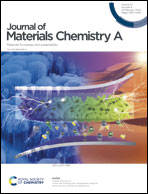Efficient dye-sensitized solar cells based on bioinspired copper redox mediators by tailoring counterions†
Abstract
In recent years, copper(II/I) complexes have attracted growing interest as redox mediators in dye-sensitized solar cells. Here, we report a new class of copper complexes bearing a bis(2-pyridylmethyl)-1,2-ethanedithiol ligand, coded as [Cu(N2S2)]2+/+, with tetrafluoroborate ([BF4]−) and hexafluorophosphate ([PF6]−) counterions. Strikingly, it is discovered that the solubility and diffusion coefficients of Cu(I) species are dramatically improved by changing the counterion from [BF4]− to [PF6]−. As a result, DSCs incorporating the latter redox system show a much enhanced short-circuit current density and fill factor, which in turn lead to a superior overall power conversion efficiency (PCE) of 10.3% under one sun illumination (100 mW cm−2, AM 1.5G). This has been the highest PCE reported so far for copper redox mediators with sulfur-coordinating ligands in DSCs. Thus, this work provides an effective strategy for further design of more efficient redox mediators in DSCs.



 Please wait while we load your content...
Please wait while we load your content...